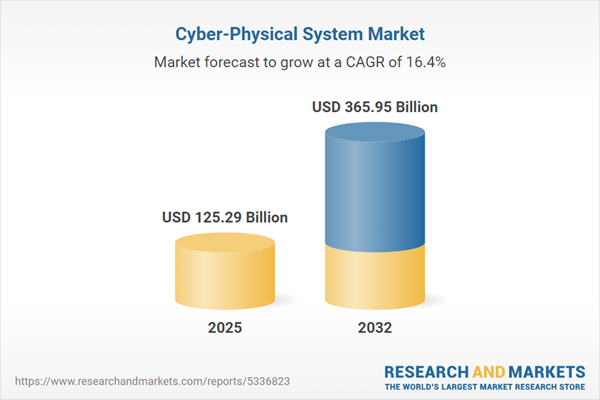Speak directly to the analyst to clarify any post sales queries you may have.
Cyber-physical systems are rapidly reshaping industrial landscapes, empowering enterprises to merge digital intelligence with real-world processes for greater efficiency, resilience, and operational insight.
Market Snapshot: Cyber-Physical System Market Growth and Outlook
The Cyber-Physical System Market grew from USD 108.63 billion in 2024 to USD 125.29 billion in 2025. It is expected to continue growing at a CAGR of 16.39%, reaching USD 365.95 billion by 2032.
Scope & Segmentation of the Cyber-Physical System Market
This report offers a comprehensive analysis of the cyber-physical system market across a broad spectrum of components, deployment models, industry verticals, regional markets, and key technology providers. The segmentation framework ensures actionable insights tailored for stakeholders seeking scalable and sustainable technology strategies.
- Component: Actuators, Communication Devices, Controllers, Sensors, Consulting Services, Integration Services, Support & Maintenance, Software
- Deployment: Cloud, On-Premises
- Industry: Aerospace & Defense, Automotive & Transportation, Banking, Financial Services & Insurance, Building, Construction & Real Estate, Consumer Goods & Retail, Education, Energy & Utilities, Government & Public Sector, Healthcare & Life Sciences, Information Technology & Telecommunication, Manufacturing
- Region: Americas, Europe, Middle East & Africa, Asia-Pacific, with detailed country coverage across the United States, Canada, Mexico, Brazil, Germany, United Kingdom, China, India, and other key markets
- Leading Companies: ABB Ltd., Cisco Systems, Cognizant Technology Solutions, Dell, Fujitsu, Galois, General Electric, Hewlett Packard Enterprise, Hitachi Vantara, Honeywell International, Infosys, Intel, IBM, KUKA AG, Microsoft, NEC, Oracle, Rockwell Automation, SAP, Schneider Electric, Siemens, Tech Mahindra, Ericsson, The MathWorks, Yokogawa Electric Corporation
Key Takeaways for Senior Decision-Makers
- Strategic investments in cyber-physical systems foster operational agility by integrating real-time data flows and autonomous control mechanisms.
- Technological convergence—encompassing edge computing, artificial intelligence, and digital twins—enables organizations to shift from reactive maintenance to predictive and prescriptive approaches, targeting process optimization and proactive asset management.
- Cloud and on-premises deployments provide flexibility to balance scalability with data sovereignty, supporting sector-specific security and compliance needs.
- Sophisticated cybersecurity measures now underpin system design, driving resilience as cyber-physical environments encounter increasingly complex threat landscapes.
- Workforce upskilling, cross-functional governance, and agile collaboration frameworks have emerged as imperatives for successful technology adoption and return on investment.
- Global and regional dynamics require technology providers to align strategies with local regulations, infrastructural maturity, and sectoral growth drivers.
Tariff Impact: Adaptation in the Cyber-Physical System Supply Chain
The 2025 tariff changes in the United States have significantly influenced procurement strategies and supply chain dynamics within the cyber-physical system sector. Increased duties on hardware components—sensors, controllers, and communication devices—prompted organizations to reconsider vendor agreements, diversify geographic sources, and explore nearshoring and regional assembly. Software and services remain less directly affected, but bundled offerings and flexible licensing have come into sharper focus as companies strive to protect margins and optimize total cost of ownership.
Methodology & Data Sources
The insights in this report are derived from structured interviews with industry leaders, a rigorous review of market literature, and validation through data triangulation. Primary research captured frontline perspectives on technology deployment and market challenges, while secondary research and expert panels ensured a robust assessment of competitive dynamics and regulatory trends.
Why This Report Matters for Cyber-Physical System Stakeholders
- Enables executive teams to match technology investments with current industry shifts and regional requirements, optimizing digital transformation efforts.
- Empowers decision-makers to anticipate supply chain risks, regulatory changes, and evolving customer expectations across diverse end-user markets.
The report supports informed strategic planning, guiding organizations to adapt offerings, form effective partnerships, and maintain a resilient market presence as the cyber-physical system market evolves.
Conclusion
By aligning cybersecurity, flexible deployment, and workforce development strategies, industry leaders can successfully capitalize on new opportunities in cyber-physical systems. This report delivers actionable knowledge for stakeholders navigating an environment marked by technological advancement and changing global dynamics.
Additional Product Information:
- Purchase of this report includes 1 year online access with quarterly updates.
- This report can be updated on request. Please contact our Customer Experience team using the Ask a Question widget on our website.
Table of Contents
3. Executive Summary
4. Market Overview
7. Cumulative Impact of Artificial Intelligence 2025
Companies Mentioned
The companies profiled in this Cyber-Physical System market report include:- ABB Ltd.
- Cisco Systems, Inc.
- Cognizant Technology Solutions Corporation
- Dell Inc.
- Fujitsu Limited
- Galois, Inc.
- General Electric Company
- Hewlett Packard Enterprise Company
- Hitachi Vantara LLC by Hitachi, Ltd.
- Honeywell International Inc.
- Infosys Limited
- Intel Corporation
- International Business Machines Corporation
- KUKA AG
- Microsoft Corporation
- NEC Corporation
- Oracle Corporation
- Rockwell Automation, Inc.
- SAP SE
- Schneider Electric SE
- Siemens AG
- Tech Mahindra Limited
- Telefonaktiebolaget LM Ericsson
- The MathWorks, Inc.
- Yokogawa Electric Corporation
Table Information
| Report Attribute | Details |
|---|---|
| No. of Pages | 190 |
| Published | November 2025 |
| Forecast Period | 2025 - 2032 |
| Estimated Market Value ( USD | $ 125.29 Billion |
| Forecasted Market Value ( USD | $ 365.95 Billion |
| Compound Annual Growth Rate | 16.3% |
| Regions Covered | Global |
| No. of Companies Mentioned | 26 |









